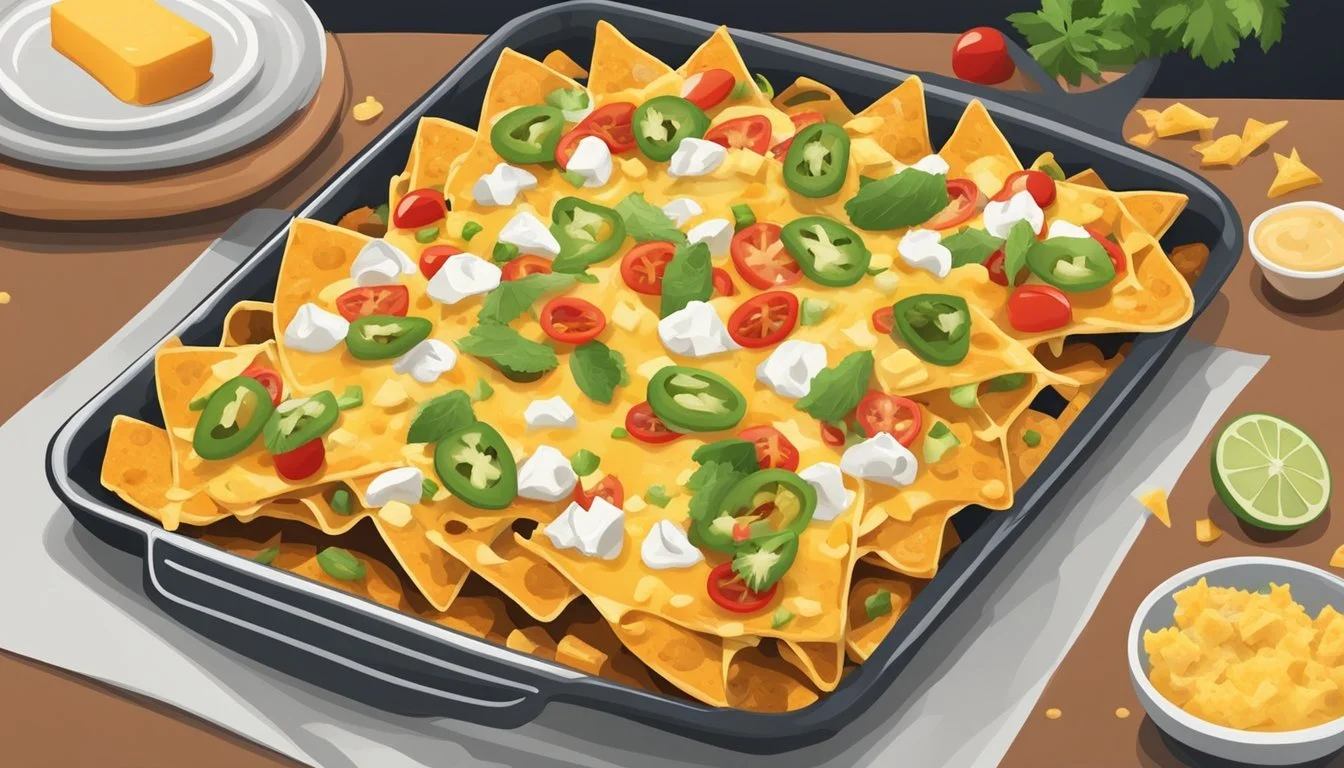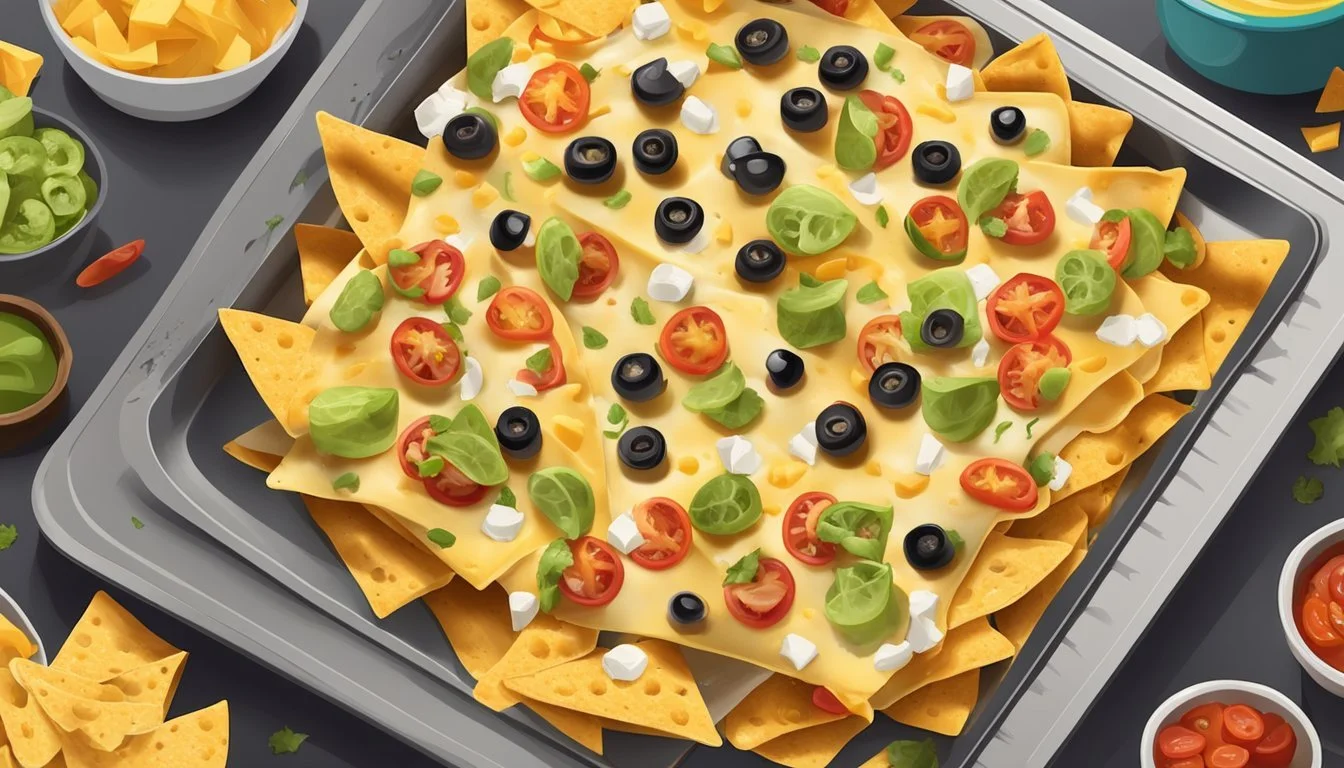Best Way to Reheat Nachos Without Making Them Soggy
Expert Techniques Revealed
Reheating nachos can be a bit of a culinary minefield, with the ever-present danger of ending up with a plate of soggy chips. Ensuring that the nachos retain their textural integrity and flavor is paramount for the enjoyment of this beloved dish. Achieving crispy and delicious reheated nachos is certainly possible with the right techniques, which involve the separation of cold toppings and precise heat control.
The key to reviving leftover nachos lies in the careful management of temperature and the preservation of the original layers of flavor. While the microwave might seem like a quick fix, it often results in a disappointing texture, so it is generally better to avoid it for this purpose. Instead, a conventional oven or an air-fryer offer the best results, distributing heat evenly without introducing additional moisture that can lead to sogginess.
An oven set to a low temperature range, typically between 225 to 300 degrees Fahrenheit, allows for a gentle rewarming that brings the nachos back to life. Protecting them with aluminum foil can prevent them from burning or becoming too dry. For those with an air fryer, this can be an effective tool for reheating nachos quickly while also helping to maintain their crispness. Preheating the device and removing any moist toppings before reheating ensures the final result is as good as the original serving.
Understanding Nachos
As one approaches the task of reheating nachos, it's essential to recognize the factors contributing to sogginess and the elements at play within the dish.
What Makes Nachos Soggy?
Soggy nachos primarily result from moisture absorption. The culprits can include toppings like salsa, jalapeños, guacamole, and sour cream that release liquid over time. This especially impacts leftover nachos as they sit, allowing tortilla chips to soak up any excess moisture, thus losing their crunch. It’s also the steam and heat from the warm ingredients, such as cheese and meat, that can lead to a moist environment, fostering sogginess in the tortilla chips.
Key Components of Nachos
Nachos consist of several layers and components that all contribute to its overall flavor and texture. At its core are tortilla chips, which provide the crunch and base for the other ingredients. Then comes a generous layer of cheese, which is ideally melted and even slightly crispy once reheated. Common nacho toppings can include beans, meat, vegetables, and a range of cold condiments. Properly reheating nachos involves heating the core elements while preserving the integrity of the cold toppings to prevent the final product from becoming soggy nachos.
Preparation for Reheating
Proper preparation is crucial for reheating nachos to ensure they retain their texture and flavor. This involves correct storage of leftovers and careful separation of ingredients before reheating.
Storing Leftover Nachos
When storing leftover nachos, it is important to keep them in an airtight container to protect them from moisture and preserve their freshness. One should remove any cold toppings, such as salsa and sour cream, which can make the chips soggy when refrigerated. Placing the leftovers in the refrigerator promptly after the meal will minimize the risk of spoilage.
Separating Ingredients
Before reheating, separate the nachos into two categories: warm ingredients and cold toppings. Warm ingredients include chips, cheese, beans, and meat. Cold toppings, such as lettuce, jalapeños, guacamole, salsa, and sour cream, must be removed and set aside. Reheating the nachos without the cold toppings prevents moisture from these components from making the chips soggy during the reheating process.
Reheating Methods
Reheating nachos requires careful technique to maintain their crispness while ensuring they are warmed through. Various methods are suited to cater to different preferences and available kitchen appliances.
Oven Method
To reheat nachos in the oven, preheat it to 350°F (177°C). Spread the nachos on a parchment-lined baking sheet to prevent sticking and ensure even heat distribution. The key is to use a single layer so that the moisture can escape, keeping the nachos crisp. Heat for about 5 to 10 minutes. Using the oven retains the textural quality of the nachos and is ideal for larger quantities.
Skillet Method
A skillet can be used for reheating nachos to maintain crispiness. Heat the skillet over medium heat with no oil or butter. Place the nachos in the skillet in a single layer and reheat for a few minutes until they are hot and crisp. A lid can be placed over the skillet for the last minute to melt the cheese. This method is quick and effective for smaller portions.
Microwave Method
For a speedy reheating option, the microwave can be used. However, it's the least effective method for maintaining crispiness. To counteract sogginess, place a paper towel underneath the nachos to absorb excess moisture. Microwave in 30-second intervals at a medium power setting, checking after each interval. This method should be used only when time is of the essence.
Toaster Oven and Air Fryer
These appliances offer a more compact way to reheat nachos compared to a traditional oven. For the toaster oven, set the temperature to 225°F (107°C) and heat for 15 minutes. As for the air fryer, preheat to 370°F (188°C) and cook for 3-4 minutes. In both cases, ensure the nachos are in a single layer to promote even reheating and crispiness. These methods work well for small to medium batches and are efficient in preventing sogginess.
Pro Tips for Crispy Nachos
To ensure nachos retain their crispiness when reheated, precise temperature control and timing are crucial, along with avoiding typical mishaps that lead to sogginess.
Right Temperature and Time
When reheating nachos in a conventional oven, set the temperature to a mild 275° F (135° C) and warm them for 5-10 minutes on a baking sheet lined with aluminum foil. This allows the nachos to heat evenly without becoming overly dry or burning. Those with a convection oven should adjust the temperature slightly lower to account for the more efficient heat distribution.
For a skillet method, use a cast-iron skillet over medium heat. Heat the nachos, covered with aluminum foil, for about 5 minutes. This method helps the cheese on your nachos melt evenly, while the skillet aids in maintaining the base chips' crispiness.
Avoiding Common Mistakes
Mistakes to avoid when reheating nachos are chiefly responsible for an undesired soggy outcome.
Remove cold toppings: Cold ingredients like lettuce or guacamole should be taken off before reheating to prevent moisture from seeping into the chips.
Single layer distribution: Whether using an oven or skillet, spread the nachos in a single, even layer to ensure every chip is heated through and crisp.
Use aluminum foil: Covering the nachos with foil helps to distribute the heat more evenly and avoids direct exposure to intense heat, particularly when using the broiler.
Monitor closely: Ovens and skillets can vary in temperature, and nachos can go from crispy to burnt quickly. Keep an eye on them to prevent overcooking.
By adhering to these specific temperature settings and times while sidestepping common reheating errors, one can enjoy crispy, warm nachos that taste freshly made.
Creative Nachos Reimagined
When leftover nachos lose their allure as a standalone dish, they find new life in innovative recipes that transform them into an exciting meal.
Using Leftover Nachos in New Recipes
Instead of reheating nachos as they are, one can incorporate them into dishes that are both delightful and unexpected. Take chilaquiles, a traditional Mexican breakfast dish. A cook simply replaces the usual tortilla base with leftover nacho chips, thus infusing the dish with the nachos' flavors, and adds spicy jalapeños and fresh eggs. The result is a hearty breakfast that revives yesterday's leftovers.
For a lunchtime twist, chefs might consider beef tostadas, using the crispy parts of the nachos as a base, topped with well-seasoned ground beef and a sprinkle of cheese. After a brief warming session in the oven to melt the cheese and warm the meat, the old become new as delicious nachos turn into a satisfying, crunchy tostada.
Final Thoughts
Reheating nachos without sogginess hinges on proper storage and careful reheating techniques. When storing leftover nachos, chefs recommend separating the cold toppings from the warm base components. Storing items like lettuce, guacamole, and sour cream in a separate container ensures they remain fresh.
For the reheating process, an air fryer or oven is preferable. They find a preheated air fryer at 370°F (187°C) to be highly effective. The key is to arrange the nachos in a single layer for air to circulate, crisping them evenly.
Alternatively, one may opt for an oven method. Temperatures should be kept between 225°F and 300°F, and the duration should be calibrated based on the desired crunchiness and the quantity being reheated. Covering the nachos with aluminum foil can help retain moisture without inducing sogginess.
Air Fryer Method:
Even distribution in the basket
Typically 3-4 minutes at 300°F (150°C)
Oven Method:
Oven-safe dish, single layer
Bake 5-25 minutes, temperature contingent on crispness preference
They advise immediacy in serving once nachos reach optimal warmth and crispness, maintaining the integrity of the dish. By following these methods, one can skillfully revive the texture and taste of nachos, preserving the culinary delight that defines this beloved dish.




